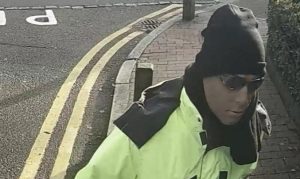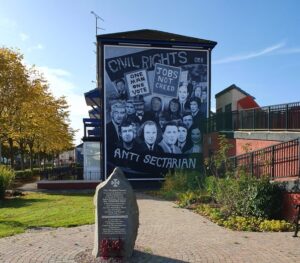Does it matter if we don’t know the truth about The Troubles?

Subscribe for free for twice-weekly true crime articles – https://totalcrime.substack.com/
By Chris Summers 1 May 2024
In the 1970s, 1980s and for most of the 1990s the news was dominated by events in Northern Ireland or by bombings which had their roots in that blighted part of the British Isles.
I remember growing up, it was like a horrible background noise which everybody tried to tune out and ignore.
I was never terribly interested in “The Troubles”, until it was over.
In 1998 The Good Friday Agreement was signed and almost overnight peace ousted violence, even if it did not bring with it a great deal of trust or sectarian harmony.
I have a weird fascination for stories which are unfashionable, no longer topical, halfway to historical.
Call it histo-journalism.
That’s why I began to get interested in Northern Ireland right around the time it was vanishing from the news bulletins.
After 9/11 there was a new type of terrorist to be scared of – suicidal Islamic zealots who did not play by any rules and certainly did not ring up with a recognised codeword before setting off bombs.
In 2007 I was working at the BBC and I managed to persuade my editor, Gary Duffy – who grew up in Northern Ireland and had covered both the IRA ceasefire and the Omagh bombing – to let me go over and cover the Billy Wright inquiry.

Wright, the leader of the Loyalist Volunteer Force (LVF), was a hardline maverick who was nicknamed “King Rat”.
On 27 December 1997 he was shot dead in The Maze prison by three gunmen from the Irish National Liberation Army (INLA).
While I was covering the inquiry I began hearing rumours about a “dirty war” which the British state was involved in.
More on that later.
This week (on 1 May) the Northern Ireland Troubles (Legacy and Reconciliation) Act comes into force and brings with it a guillotine clause which means dozens of unfinished inquests from that era will be discontinued.
Among them are the Springhill massacre in 1972 and the so-called Stalker-Stampson inquests.
One of the inquests which made it under the wire was that which looked into the Kingsmill massacre, the slaughter of 10 Protestant workmen by the IRA in 1976.

Alan Black, who survived the Kingsmill massacre, said the inquest was totally unsatisfactory because the IRA had not engaged with it at all.
But he said: “Why would they implicate themselves? Turkeys don’t vote for Christmas. Kingsmill is something they’re totally ashamed of. They don’t know how to handle it.”
The government has set up a body with the less-than-snappy title of the Independent Commission for Reconciliation and Information Recovery (ICRIR), which is supposed to work like South Africa’s truth and reconciliation commission, which delved into the darkest deeds of the apartheid era.
The deal is that former terrorists and retired soldiers are supposed to tell the truth in return for immunity.
Critics say the legislation was cooked up by junior defence minister Johnny Mercer – himself a former soldier – and the Conservative hierarchy in order to give a free pass to those army veterans who might have been implicated in the darkest acts of The Troubles.
In 2009 I returned to Northern Ireland to interview a number of people who had been affected by The Troubles.
At the time a new initiative, The Eames Bradley Report, was being published and it came up with a number of recommendations about how to deal with the legacy of The Troubles – most of which were largely ignored.
One of the people I interviewed was Martin Mallon, whose 76-year-old aunt, Roseanne Mallon, was shot dead on 8 May 1994 as she walked the television in her cottage in the village of Killymoyle, just outside Dungannon.

He was convinced that not only had Billy Wright – who was then leading the Ulster Volunteer Force’s mid-Ulster brigade but would later break away to create the LVF – or one of his henchmen been responsible, but that the British state had colluded with the killers.
It was suggested to me that senior figures in the British military – with or without the knowledge of the British government – set out on a new and deliberate strategy in the early 1990s which ultimately forced Sinn Fein/IRA to the negotiating table.
But it was a “dirty war”.
Frustrated by their inability to stop the IRA’s campaign of bombings and shootings, the top brass – so the theory goes – decided to unleash loyalist death squads who would target innocent Catholics, especially those who were related to IRA or Sinn Fein members.
Martin Mallon served seven years in jail for possessing explosives and was released in 1993.
He told me he came out of prison determined to find a political solution to The Troubles.
But he believed his name, and those of his relatives, had already found their way onto the loyalist death lists.
In the final years of The Troubles loyalists killed more people than the republicans: 48 in 1993 (compared with 39), 38 in 1994 (27), and 13 in 1997 (5).
It was even suggested to me during one of my visits to Northern Ireland that the British state deliberately allowed the INLA to kill Wright because he was out of control and his sectarian killings were threatening to derail the peace process.
The second plank of the British government’s secret strategy – so the theory goes – was a “shoot-to-kill” policy which gave the SAS and other military units carte blanche to despatch IRA and INLA men without the need to get the legal system involved.
The first suggestion there was a shoot-to-kill policy emerged in the 1980s.
In 1982 five men – Gervaise McKerr, Sean Burns, Eugene Toman, Seamus Grew and Roddy Carroll – and a 17-year-old youth, Michael Tighe, were shot dead by the RUC’s Special Support Unit (SSU) at checkpoints in County Armagh.
John Stalker, the deputy chief constable of Greater Manchester Police, was tasked with investigating the deaths but in 1986 he was controversially removed after an attempt to tarnish his reputation.
Colin Sampson, the chief constable of West Yorkshire Police, was drafted in to finish the investigation but found his work obstructed by MI5 and the RUC.
Forty years later there is still no clarity about these shoot-to-kill deaths.
In 2009, while I was in Northern Ireland for the Eames-Bradley report, I also met relatives of three IRA men who were ambushed and killed by the SAS.

On June 3, 1991, Michael “Pete” Ryan, 37, Lawrence McNally, 39, and Tony Doris, 21, were gunned down in the village of Coagh in County Tyrone (pictured above) by a SAS soldiers, who had set up an ambush.
Their car collided with another vehicle and a wall and was engulfed in flames.
Doris was a cousin of Michelle O’Neill – who is now the first minister of Northern Ireland and vice president of Sinn Fein, which was at the time of the attack the political wing of the Provisional IRA (PIRA).
When I met Ryan’s brother, Sean, and his cousin Tarlac Connolly, they claimed the three men had been finished off in cold blood by the SAS and then put back in the car before it was set on fire.
The Coagh inquest finished last week and, reading out his verdict, the coroner, Mr Justice Michael Humphreys, set the context: “In the late 1980s and early 1990s there had been a surge of activity involving the East Tyrone brigade of the IRA.”
In May 1987 the SAS killed eight members of the East Tyrone brigade at Loughgall but in August 1988 the IRA killed eight soldiers at Ballygawley.
Three more soldiers were killed in an IRA attack on the Glenanne barracks on 31 May 1991.
He said this was the “bloody backdrop” to the events of June 3, 1991, when three members of the IRA’s East Tyrone Brigade set out to kill a former member of the Ulster Defence Regiment (UDR) in Coagh.
But the SAS had got wind of their plans and were lying in wait, hidden behind a riverside hotel and in a flatbed lorry.
An SAS soldier even posed as the target in a car park, dying his hair to match the man the IRA wanted to assassinate.
A video was taken of the whole incident by one of the soldiers but it was later destroyed because the SAS team feared it would identify them.
Judge Humphreys was scathing in his criticism of the soldiers and the top brass who backed them up.
He said: “The soldiers’ attitude showed a clear and unequivocal willingness to subvert the rule of law.”
He then went on to criticise senior officers in the army who he said had taken every opportunity to, “excuse, justify, and support this reprehensible conduct.”

But he said he believed the soldiers held an “honest and genuine belief” their lives or that of their comrades were in danger and he said their use of lethal force was “reasonable and proportionate.”
Afterwards solicitor Padraig O’Muirigh, who acted for the families of Peter Ryan and Tony Doris, claimed the SAS had deliberately set up a “kill zone” and had no intention of trying to arrest the men.
He said: “What we see in the aftermath is a very clear cover-up of that shoot-to-kill policy, both in terms of how the British Army destroyed a crucial video which would have assisted this coroner and important documentation relevant to the inquest.”
The Troubles lasted between 1969 and 1998 and more than 3,600 people were killed by the PIRA, other Irish republican groups, loyalist paramilitaries, and the security forces.
But it seems we are no nearer finding out the truth about The Troubles or the dirty war which Britain may – or may not – have declared in order to force the Provos to put down their weapons.






